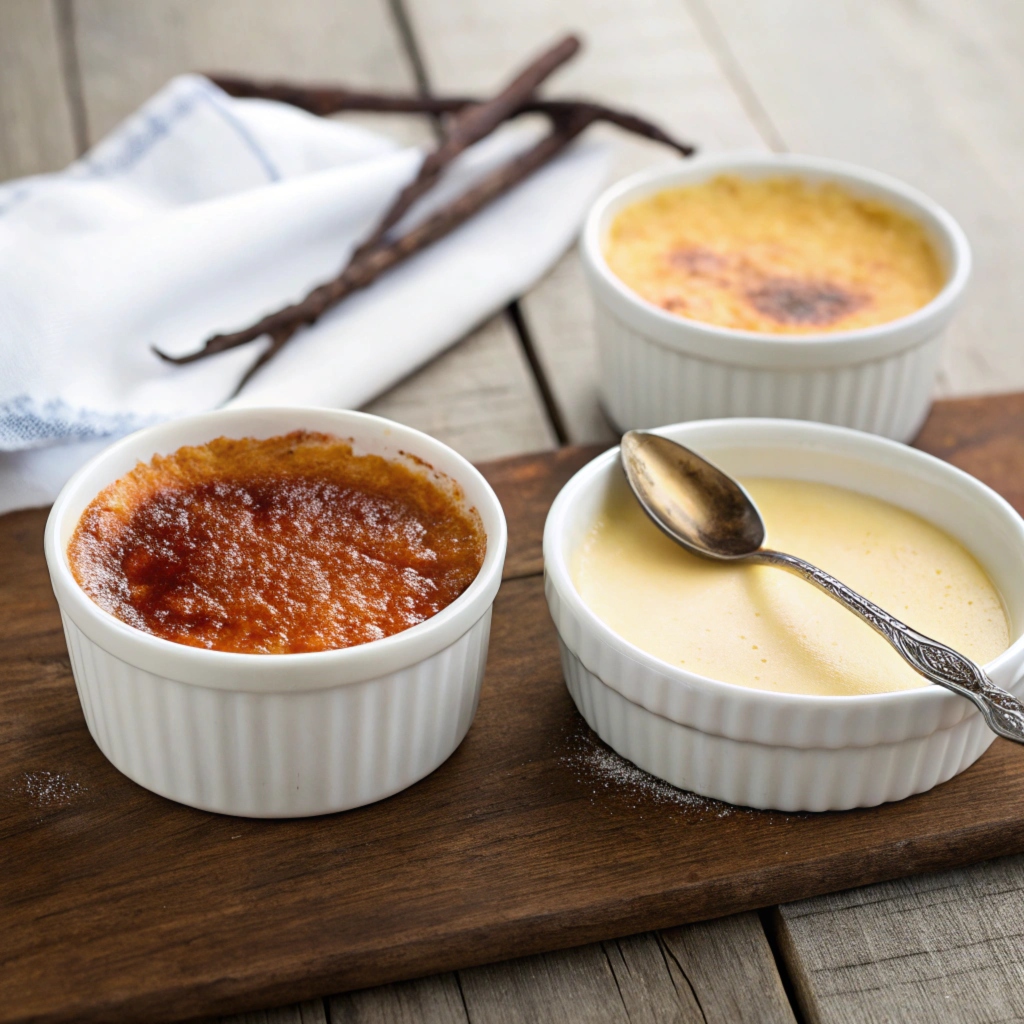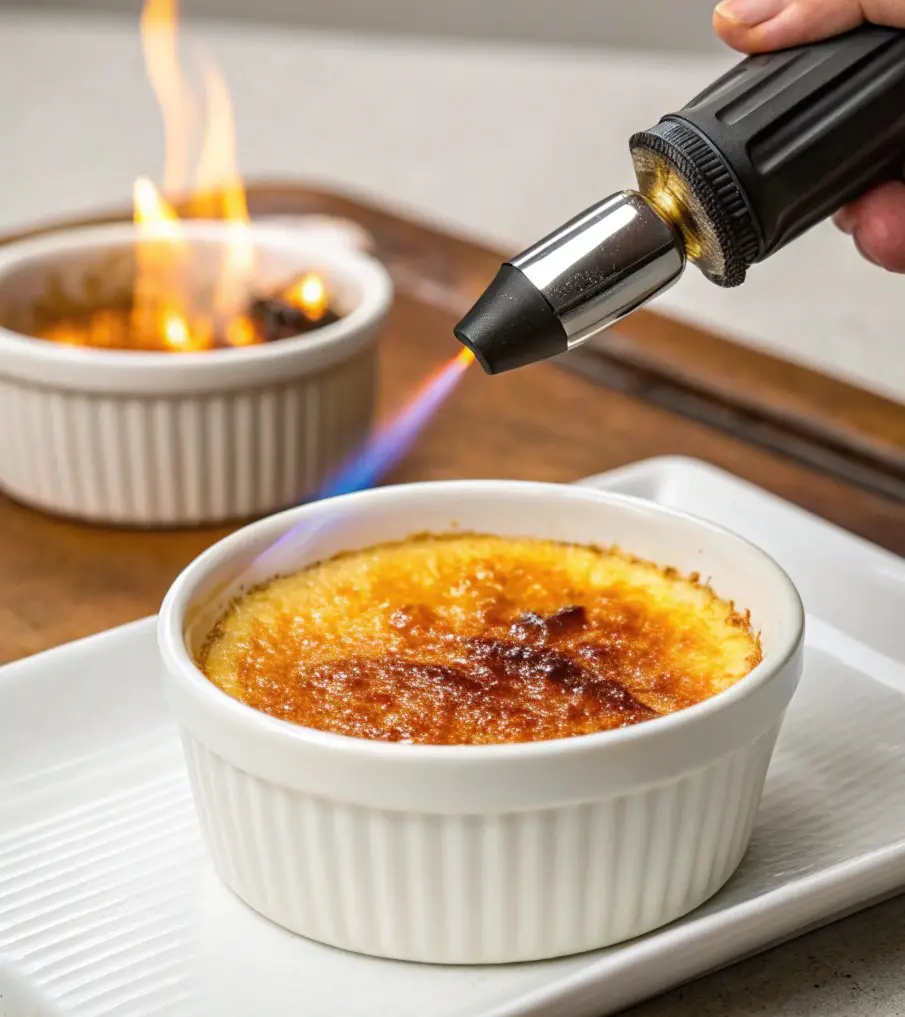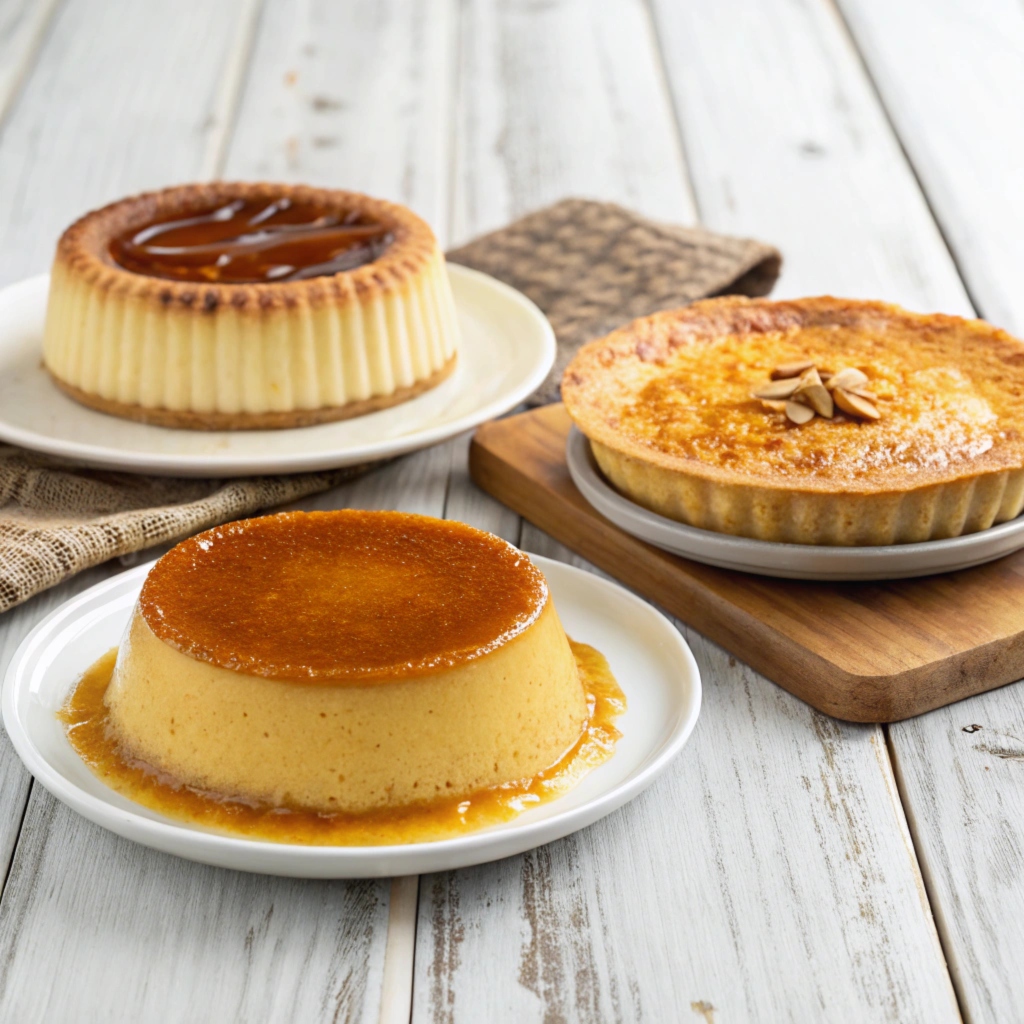Crème brûlée and custard delight dessert lovers but often confuse even the most dedicated food enthusiasts. Difference between crème brûlée and custard, Both share a creamy, velvety texture and use similar ingredients, but their preparation methods, presentation, and taste clearly set them apart. If you’ve ever wondered why crème brûlée features an iconic crunchy sugar top or how custard transforms into pie fillings, sauces, or standalone desserts, this guide will provide all the answers.
We’ll break down the essential differences between crème brûlée and custard, covering their ingredients, textures, cooking techniques, and uses. By the end, you’ll know exactly which dessert to make or order when craving something sweet and silky.
Chefs and pastry enthusiasts often associate crème brûlée with elegance and luxury, thanks to its signature “crackable” caramelized sugar crust. In contrast, custard showcases its versatility, enhancing everything from pies and tarts to rich dessert sauces. But the differences go even deeper. Let’s take a closer look at what makes crème brûlée so special.

Table of contents
What is Crème Brûlée?
Definition of Crème Brûlée
Crème brûlée, meaning “burnt cream” in French, is a classic dessert that has won the hearts of dessert lovers worldwide. This iconic treat features a unique dual texture — a smooth, velvety custard base topped with a hard, glassy layer of caramelized sugar. When you tap the sugar crust with a spoon, it cracks to reveal the soft custard below. This satisfying “crack” is one of the most memorable and enjoyable moments of the dessert experience.
Chefs typically serve crème brûlée in single-portion ramekins, making it a perfect choice for formal dining. Its rich flavor and elegant presentation have earned it a spot on fine dining menus and high-end restaurant dessert lists.
Key Ingredients of Crème Brûlée
To achieve the rich, creamy consistency and caramelized sugar topping, crème brûlée relies on a few simple but essential ingredients:
- Heavy Cream: Provides the rich, silky base.
- Egg Yolks: Thicken the custard and give it structure.
- Sugar: Used in both the custard and the caramelized topping.
- Vanilla: Adds depth and warmth to the flavor.
Optional flavor additions like chocolate, coffee, or fruit infusions can add variety to the classic recipe. However, the traditional vanilla version remains the most popular.
How Crème Brûlée is Made
Making crème brûlée requires precision, patience, and attention to detail. Here’s a step-by-step guide on how to prepare it:
1. Custard Preparation
- Whisk egg yolks and sugar until the mixture turns pale and thick.
- Heat heavy cream with vanilla (or other flavors) until it’s warm but not boiling.
- Slowly pour the warm cream into the egg mixture while whisking continuously to prevent curdling.
2. Baking the Custard
- Pour the custard mixture into ramekins.
- Place the ramekins in a water bath (bain-marie) to ensure gentle, even cooking.
- Bake at a low temperature to prevent overcooking, which could cause the custard to curdle.
3. Creating the Caramelized Sugar Crust
- After the custard sets and cools, sprinkle sugar evenly on top of each ramekin.
- Use a kitchen torch (or broiler) to melt and caramelize the sugar, forming a hard, glass-like crust.
The result is a dessert that contrasts two textures — the crisp, sugary top and the silky, creamy base. The first crack of the spoon through the sugar crust is a moment of satisfaction that dessert lovers look forward to.
Unique Features of Crème Brûlée
Crème brûlée’s fame doesn’t come from its ingredients alone. Its presentation and eating experience make it truly unforgettable. Here are some of its unique features:
- Crunchy Sugar Top: The hardened, caramelized sugar top sets it apart from other custard-based desserts.
- Silky Smooth Texture: Unlike other baked custards, crème brûlée has a rich, velvety consistency.
- Individual Servings: It’s typically served in single-serving ramekins, giving it a sophisticated, elegant feel.
- Spoon Tap Satisfaction: The act of tapping through the sugar crust is a small but iconic moment that adds to the sensory appeal of this dessert.
Now that you know what makes crème brûlée unique, let’s take a closer look at its cousin — custard.
What is Custard?
Definition of Custard
Custard is a versatile dessert that has delighted people in kitchens around the world for centuries. This classic treat combines milk (or cream), eggs, sugar, and flavorings like vanilla, nutmeg, or cinnamon. Unlike crème brûlée, which features a crisp sugar crust, custard offers a soft, smooth, and uniform texture throughout.
Custard offers far more flexibility than crème brûlée in terms of usage. You can serve it as a simple standalone dessert, pour it as a sauce over cakes and fruits, or use it as a creamy filling for pastries, pies, and tarts. This adaptability has made custard a key component in popular desserts like custard tarts, trifle, and the rich, decadent Boston cream pie.
Custard appears in many forms, from the pourable silkiness of crème anglaise to the firm, sliceable texture found in pies. The cooking method determines its final consistency, allowing for smooth, sauce-like custards or firm, solid versions used in baked goods.
Custard relies on a few essential ingredients, each playing a vital role in its texture, flavor, and consistency:
- Milk or Cream: The liquid base of custard. Milk creates a lighter texture, while cream makes it richer and thicker.
- Eggs: Whole eggs or yolks thicken the custard as proteins coagulate during cooking, turning the liquid into a creamy, gel-like consistency.
- Sugar: Adds sweetness, with the amount varying depending on the desired flavor.
- Flavorings: Bakers and chefs frequently flavor custard with vanilla, but they also add nutmeg, lemon zest, cinnamon, or chocolate for variety.
Some custard variations, like pastry cream (crème pâtissière), include cornstarch or flour as a thickening agent to create a more stable, pipeable filling for éclairs, cream puffs, and tarts.

Key Ingredients of Custard
How Custard is Made
Cooks prepare custard using three main methods, each creating a unique texture and consistency. These techniques offer versatility, allowing you to use custard as a sauce, filling, or standalone dessert.
1. Baked Custard
How It’s Made: Chefs whisk eggs, sugar, milk (or cream), and flavorings together until well combined. They pour the mixture into ramekins or baking dishes and bake it in a water bath (bain-marie) at a low temperature. This method ensures gentle, even cooking and prevents curdling.
Texture: Firm and sliceable, with a smooth, silky surface.
Example Desserts:
- Flan: A baked custard topped with caramel sauce.
- Crème Caramel: Similar to flan but with a richer caramel layer.
- Custard Tarts: Mini tarts filled with smooth, sweet custard.
2. Stirred Custard (Stovetop Custard)
It’s Made: Chefs cook eggs, milk (or cream), sugar, and flavorings in a saucepan over low heat. They stir constantly to prevent curdling and achieve a smooth, even texture.
Texture: This custard has a silky, smooth, and pourable consistency, but extended cooking can make it thicker.
Example Desserts:
- Crème Anglaise: Chefs prepare this pourable custard sauce to serve with cakes, brownies, or fruit.
- Pastry Cream (Crème Pâtissière): Bakers create this thicker custard as a filling for éclairs, cream puffs, and fruit tarts.
3. Set Custard (Chilled Custard)
Made: Cooks prepare custard on the stovetop, then pour it into molds or dessert dishes. After cooling, they chill it in the refrigerator until it firms up to a sliceable consistency.
Texture: Chilled, smooth, and firm enough to slice.
Example Desserts:
- Banana Pudding: Layers of vanilla custard, bananas, and cookies.
- Trifle: Custard layered with sponge cake, fruit, and whipped cream.
- Chilled Vanilla Custard: A standalone dessert served cold, often topped with fruit or caramel.
Unique Features of Custard
- Soft, Creamy Texture: Can range from silky-smooth sauces to firm, sliceable fillings.
- Versatility: Used as a dessert, sauce, filling, or layer in trifles and tarts.
- Simple Ingredients: Made from pantry staples like milk, sugar, and eggs.
- Multiple Cooking Methods: Baked, stirred, or chilled, each method creates a different texture.
Common Uses of Custard
Custard is one of the most adaptable dessert components. Here’s how it’s used:
- As a Sauce: Pour crème anglaise over cakes, brownies, or fruits for a creamy, sweet finish.
- As a Pie or Tart Filling: Found in custard tarts, egg tarts, and Boston cream pie.
- As a Dessert: Enjoy on its own as flan, chilled vanilla custard, or pudding.
- As a Layer in Trifles: Adds creaminess to layered desserts with sponge cake and fruit.
- As a Pastry Cream: Used as a filling for éclairs, cream puffs, and fruit tarts.
Custard Use Cases
Sauce: Chefs serve custard (like crème anglaise) as a pouring sauce for cakes, brownies, and fruits.
Filling: Bakers use custard as a filling for pies, tarts, éclairs, and cream puffs.
Dessert: Custard works perfectly as a standalone dessert, including classics like flan, pudding, or custard tarts.
Layer: Dessert makers layer custard in trifles along with sponge cake, fruit, and whipped cream.
Key Takeaway: Custard offers far more versatility than crème brûlée. You can use it as a sauce, filling, or pie layer, while chefs typically serve crème brûlée as a standalone dessert.
Summary of Key Differences
| Criteria | Crème Brûlée | Custard |
|---|---|---|
| Texture | Creamy with hard sugar crust | Smooth, soft, or firm throughout |
| Ingredients | Heavy cream, yolks, sugar, vanilla | Milk/cream, eggs, sugar, vanilla |
| Cooking Method | Baked, torched sugar crust | Baked, stovetop, or chilled |
| Appearance | Glossy, golden sugar crust | Smooth, uniform top |
| Use Cases | Standalone dessert | Sauce, filling, layer, dessert |
| Taste | Rich, sweet, caramelized | Mild, sweet, versatile flavors |

Frequently Asked Questions (FAQs) About Difference between crème brûlée and custard
1. Is crème brûlée the same as custard?
No, but they are related. Crème brûlée is a type of custard, but not all custards are crème brûlée. Custard is a broad category of desserts made with eggs, sugar, and milk or cream, which thickens as it cooks. Crème brûlée is a specific version of custard that is topped with a caramelized sugar crust.
While both have a smooth, creamy texture, custard is uniform throughout, while crème brûlée has a crisp, glassy layer on top. Other examples of custards include flan, crème caramel, and pastry cream.
2. What are the 3 types of custard?
The three main types of custard are:
- Baked Custard: Firm and sliceable, often found in flan, crème caramel, and custard tarts. It is baked in a water bath to prevent curdling.
- Stirred Custard: Cooked on the stovetop and stirred continuously to prevent curdling. Examples include crème anglaise (pouring custard) and pastry cream.
- Set Custard: Custard that is cooked, then cooled and set in the refrigerator. Examples include trifles, banana pudding, and chilled vanilla custard.
Each type has a different texture and use, from pourable sauces to sliceable fillings for pies and tarts.
3. Is crème brûlée served warm or cold?
Crème brûlée is served cold with a warm, freshly caramelized sugar crust. The custard is cooked, then chilled in the refrigerator until firm. Before serving, sugar is sprinkled on top and caramelized using a kitchen torch or broiler.
This contrast in temperature is part of its appeal — the cool, creamy custard below and the warm, crisp sugar on top create a unique sensory experience.
4. What is the English version of crème brûlée?
The English version of crème brûlée is sometimes called “burnt cream”. This name is a direct translation of the French term “crème brûlée,” which means “burnt cream.”
A similar dessert in English cuisine is “Trinity Cream”, which was first served at Trinity College, Cambridge, in the 17th century. Like crème brûlée, Trinity Cream has a smooth custard base with a caramelized sugar crust. The only difference is the origin and cultural context.
More Ideas
1. Dessert Recipes and Variations
- Discover a savory twist on custard with this rich and creamy Crab Brûlée Recipe, featuring a custard-like base with a crisp caramelized top.
- If you enjoy custard-like textures, try this Almond Nut Cake Recipe, a rich, nutty dessert that pairs well with custard-based sauces.
2. Baking Tips and Techniques
- Want a silky, smooth custard? Learn the Secret to Super Moist Cake — many of the same techniques apply to custards and crème brûlée.
- Thinking of experimenting with alternative flours in your custard-based recipes? Check out Baking with Almond Flour for insights on how it affects texture and taste.
3. Almond and Marzipan Creations
- Custard-like fillings often feature almond-based ingredients. Explore the Difference Between Marzipan and Almond Paste to see which one works best for your baked treats.
- Enhance your almond-based custard or cake with ideas from What Flavor Goes Well With Almond Cake?. Vanilla, chocolate, or fruit pair perfectly with custard.
4. Hearty Savory Inspirations
- Craving something heartier? Try a custard-inspired savory dish like this Easy Pastalaya Recipe, a rich, comforting one-pot meal.
- Learn about the key ingredients that make this dish stand out with What is Pastalaya Made Of? — a helpful read if you’re exploring different textures like custards and stews.
Conclusion
Crème brûlée and custard may seem similar at first, but they have distinct differences in texture, preparation, and presentation. While crème brûlée is a luxurious dessert known for its crispy caramelized sugar crust and velvety custard base, traditional custard is much more versatile. Custard serves as the foundation for a wide range of desserts, from flan and crème caramel to pie fillings and sauces.
The key distinctions lie in the ingredients, cooking methods, and serving styles. Crème brûlée is always served as a standalone dessert with its signature “crackable” top, while custard can be baked, stirred, or chilled, offering multiple textures and uses.
If you’re craving a show-stopping dessert that’s both indulgent and elegant, crème brûlée is the clear winner. However, if you want a versatile base for tarts, pies, or creamy dessert sauces, custard is your best bet. Understanding the difference between the two can help you choose the perfect dessert for your next dinner party or family gathering.
Now that you know the difference between crème brûlée and custard, why not try making one at home? Explore related recipes like the savory Crab Brûlée Recipe or experiment with custard-inspired desserts like this nutty, indulgent Almond Nut Cake Recipe. For more dessert inspiration, don’t miss our guide on Baking with Almond Flour for unique twists on traditional recipes.
Whether you’re a fan of the iconic “crack” of crème brûlée or the silky smoothness of custard, you now have the knowledge to create either one with confidence. Enjoy exploring these delicious desserts!
